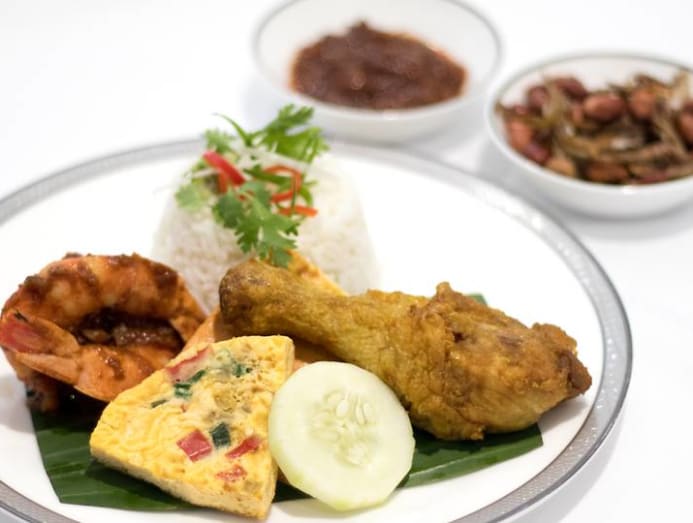Commentary: A piece of Southeast Asia in a Singapore dish
SINGAPORE: The sun is setting, and a pot rages to a eddy on the stove, the odour of aromatic spices wafting through the air.
On the tabular array, fresh craven is prepped for the oven, while fragrant coconut rice steams steadily in the cooker.
A fiddling girl sits on a high stool, looking on curiously equally vegetables sizzle in a wok while sugar and chilli caramelise in a pan.
This is the home many of us grew upward in, where nutrient is literally the center of the universe.
Nosotros would get together at dusk, sitting in our dining rooms, chatting about our days over a warm basin of rice and delectable dishes, at times catastrophe dinner with a basin of sweet treats – red bean soup, kueh – the listing is countless.
It is only when we grow older that we start to remember more than deeply about the origins of our food. As far equally we know, Singapore generates precious petty of our locally consumed produce. And then where does all this food come from?
Singapore sits in the cradle of Southeast Asia, and our palates have long been accustomed to the diverse and colourful tastes of our region. Yet many of the states may non be aware of how much of our nutrient comes from our neighbours.
Southeast Asia, a region of robust agricultural development and multifariousness, has availed the presence of a rich variety of produce making their way to our urban center-country.
READ: UNESCO list may lift hawker civilisation simply saving it is a different challenge, a commentary

Nutrient FROM OUR NEIGHBOURS
In every well-stocked kitchen in Singapore, one is likely to notice at to the lowest degree a few essential products from ASEAN countries. A groceries shopping trip to NTUC Fairprice will reveal several interesting facts about the many origins of our nutrient.
While Malaysia is often perceived to be the main exporter of produce to Singapore, including meat, seafood, spices, fruit and vegetables, much of our kitchen stock also comes from other ASEAN countries.
This includes jasmine rice from Thailand, sweet irish potato and coffee from Vietnam, mangos from Myanmar and the Philippines, and even Kolo Mee from Negara brunei darussalam.
Fifty-fifty in a uncomplicated dish of noodle soup that one might whip upwards in their kitchen, there might be chicken from Malaysia, organic chye sim from Thailand, and spices from Republic of indonesia.
In some other local favourite, fried rice, most ingredients are sourced from our neighbours too – rice from Thailand, eggs from Malaysia, garden peas from Vietnam, carrots from the Philippines, garlic and spring onions from Indonesia and shrimp from Brunei.
The region has, literally, come up to our kitchen, existence present in nearly every local Singaporean delicacy, from nasi lemak to char kway teow.
The presence of ASEAN in Singapore kitchen is emblematic of the multi-fold and far-reaching benefits of enhanced regional merchandise in agricultural products.
READ: Healthier options 'killing the hawker vibe'? Why so resistant, Singaporeans? A commentary

Malaysia, Indonesia, Thailand and Vietnam are among the height ten exporters of food products to Singapore.
Thailand and Vietnam especially are among the top three rice exporters to Singapore, accounting for 62 per cent of its total rice imports.
Nutrient SECURITY
A number of ASEAN initiatives have been put in place to enhance the sustainability of Singapore's food imports, including the Asean Integrated Food Security (AIFS) Framework which provides an enabling environs for Asean member states to operate and cooperate in various aspects related to food production, processing and merchandise.
With the ever-nowadays threat of climate change, episodic droughts, floods and other natural disasters, information technology is of utmost importance that Singapore join hands with other Asean countries to enhance food security in the region, including promoting conducive food market trade, agri-innovation and nutrient security emergency arrangements.
I notable achievement in this respect is the Association of southeast asian nations Plus Three Emergency Rice Reserve established in 2013.
With earmarked stocks and voluntary donations from ten Association of southeast asian nations member states plus China, Nippon and the Commonwealth of Korea, this reserve offers rice supplies for affected countries particularly in times of acute emergency.
Now when I recall my babyhood, I think non only of the bursts of flavour in every bite, only the lustrous fields across the region from which my rice and noodles hail.
When it comes to food, ASEAN is e'er present in our home as much as we have e'er been right at dwelling in the ASEAN region. These culinary connections highlight the intimate ties that demark Singapore to and with ASEAN.
Cheryl Teh is Enquiry Acquaintance at the Asean Studies Eye, ISEAS-Yusof Ishak Institute. This commentary was first published in Asean Focus Issue 4.
Source: https://cnalifestyle.channelnewsasia.com/dining/asean-singapore-local-dishes-hawker-food-security-218256
Post a Comment for "Commentary: A piece of Southeast Asia in a Singapore dish"